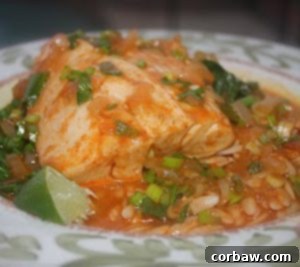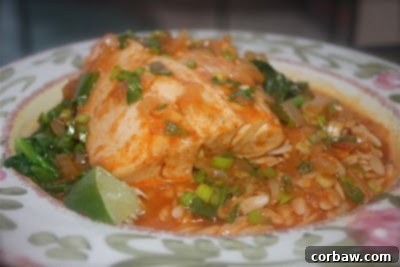Savoring Thai-Style Mahi with Coconut-Curry Broth: A Healthy & Flavorful Recipe Adventure
Embarking on new culinary adventures is one of the joys of cooking, yet even the most enthusiastic home chefs can find themselves in a rut, or hesitant about certain ingredients or cuisines. I must confess, when this particular recipe for Thai-Style Mahi with Coconut-Curry Broth was selected for our Craving Ellie in my Belly group, a wave of hesitation washed over me. While my passion for cooking runs deep, I’ve always had a few personal hang-ups when it comes to specific types of food preparation – roasts, for instance, or anything involving yeast, often feel like uncharted territory. Curry, too, fell into that somewhat intimidating category for me.
Despite this initial apprehension, I knew from past experiences that I’d enjoyed several curry dishes immensely. There’s a rich, aromatic complexity to a well-made curry that is undeniably satisfying. After a brief but firm internal pep talk, I convinced myself that this was precisely the kind of challenge I needed. It represented a fantastic opportunity to venture beyond my culinary comfort zone, to explore new flavors and techniques, and ultimately, to inject some much-needed novelty back into my kitchen routine. Breaking free from familiar cooking patterns is incredibly important for keeping the art of cooking fresh and exciting.
The Simplicity of Sourcing & The Delightful Outcome
One of the pleasant surprises about this Thai-Style Mahi with Coconut-Curry Broth recipe is its relatively simple ingredient list. Most items are readily available, making it an accessible dish for home cooks. You’ll find red curry paste – a foundational ingredient for authentic Thai flavors – in the Asian foods aisle of most well-stocked grocery stores. Alternatively, if red curry paste isn’t immediately at hand, a good quality curry powder can be substituted, typically found alongside other spices. For this particular culinary journey, I opted for the vibrant and robust red curry paste, eager to experience its depth of flavor.
For the star protein, I utilized some frozen mahi-mahi fillets I had conveniently stashed away in my freezer. Mahi-mahi is an excellent choice for this recipe due to its firm, flaky texture and mild flavor, which perfectly absorbs the rich broth without being overpowered. The beauty of this recipe truly lies in how quickly these humble ingredients transform into something truly extraordinary.
And what a delight it was! From the very first spoonful, this dish proved to be incredibly light, yet bursting with fresh and complex flavors. Both my husband and I were thoroughly impressed and enjoyed every single bite. The combination of ingredients created a harmonious symphony on the palate; I’m always particularly thrilled when cooking with the bright, herbaceous notes of fresh cilantro and the zesty tang of lime. These elements are non-negotiable for achieving that quintessential Thai-inspired freshness.
This Thai-Style Mahi with Coconut-Curry Broth is definitely going into my regular rotation. It’s the kind of healthy, flavorful meal that satisfies without feeling heavy. In fact, I’m already planning my next iteration! Next time, I’m thinking of trying this recipe with succulent shrimp, perhaps even adding a little extra heat to kick things up a notch. The versatility of this broth is truly inspiring, inviting endless possibilities for customization.
A Grateful Nod & The Power of Culinary Communities
A huge thank you goes out to Liz over at The Not So Skinny Kitchen for selecting this fantastic recipe. It’s precisely because of picks like these that I’m encouraged to try dishes I might otherwise have overlooked due to my perceived “cooking hang-ups.” The collaborative spirit within groups like CEimB is truly invaluable, pushing us all to grow and learn in the kitchen.
I highly recommend visiting Liz’s blog to see her take on this recipe, along with the other talented members of CEimB. It’s always fascinating to see the different versions and creative variations that emerge when a group of passionate cooks tackles the same recipe. Each interpretation offers unique insights and often sparks new ideas for future meals.
Recipe: Thai-Style Mahi with Coconut-Curry Broth
This recipe, adapted from the renowned Ellie Krieger, is a testament to how healthy eating can also be incredibly delicious and satisfying. It combines fresh ingredients with a fragrant, light broth to create a dish that is both nutritious and deeply flavorful. Perfect for a weeknight meal or an impressive dinner party, this Thai-style mahi is sure to become a staple in your kitchen.
Print Recipe
Thai-Style Mahi with Coconut-Curry Broth

Ingredients:
- 2 teaspoons vegetable oil
- 4 shallots, finely chopped (about 3/4 cup)
- 2 1/2 teaspoons red curry paste, or 2 teaspoons curry powder
- 2 cups low-sodium chicken broth
- 1/2 cup light coconut milk
- 1/2 teaspoon salt, plus 1/4 teaspoon, plus more for seasoning
- 4 (6-ounce) pieces mahi-mahi (or other firm white fish like halibut, cod, or even shrimp)
- 1/2 cup coarsely chopped fresh cilantro leaves
- 2 scallions, green part only, thinly sliced
- 2 tablespoons fresh lime juice (from about 1-2 limes)
- Freshly ground black pepper, to taste
- 2 cups cooked whole wheat orzo or brown rice, for serving
- Steamed spinach, for serving
Directions:
- In a large saute pan or deep skillet, heat the vegetable oil over moderate heat until shimmering. Add the finely chopped shallots and cook, stirring occasionally, until they begin to soften and turn a light golden brown, typically 3 to 5 minutes. This step is crucial for building a flavorful base for your broth.
- Stir in the red curry paste (or curry powder) and cook, stirring continuously for about 30 seconds. The heat will help to toast the spices, releasing their full aromatic potential and deepening the flavor of the broth. Be careful not to burn the paste.
- Pour in the low-sodium chicken broth and light coconut milk. Add 1/2 teaspoon of salt. Bring the mixture to a gentle simmer and let it cook, stirring occasionally, until the liquid has reduced to approximately 2 cups. This reduction process concentrates the flavors, creating a more intense and delicious broth, which should take about 5 minutes.
- While the broth is simmering, pat the mahi-mahi fillets dry and season them evenly with the remaining 1/4 teaspoon of salt, along with some freshly ground black pepper. Once the broth has reduced, carefully arrange the seasoned fish fillets in a single layer within the pan. Gently shake the pan or spoon the broth over the fish to ensure they are well-coated with the aromatic sauce.
- Cover the pan and continue to cook over moderate heat. The fish should cook until it flakes easily with a fork, which typically takes about 7 minutes, depending on the thickness of your fillets. Avoid overcooking to keep the mahi-mahi moist and tender.
- To serve, divide the steamed spinach among four soup plates, forming a small mound in the bottom of each. Carefully place a cooked fish fillet on top of the spinach.
- Stir the fresh cilantro, thinly sliced scallions (green parts only), and fresh lime juice into the simmering broth. Taste the sauce and adjust seasonings as needed with additional salt and pepper, or even a squeeze more lime juice for brightness.
- Ladle the fragrant coconut-curry broth generously over the fish and spinach. Serve immediately with a side of cooked whole wheat orzo or brown rice, which will absorb the wonderful flavors of the broth.
Recipe adapted from Ellie Krieger, The Food You Crave or Food Network
Follow AggiesKitchen on Instagram and show us what recipes you are making from the blog! Use the hashtag #aggieskitchen – I’d love to see what you are cooking up!
Tips for Success and Delicious Variations
To truly elevate your Thai-Style Mahi with Coconut-Curry Broth, consider these tips. Always choose fresh, high-quality ingredients, especially your cilantro and limes, as their vibrant flavors are key to the dish’s success. When working with red curry paste, remember that heat levels can vary significantly between brands, so start with the recommended amount and adjust to your preference. Don’t be afraid to add a pinch of red pepper flakes for an extra kick if you enjoy spicy food.
For the fish, while mahi-mahi is excellent, this recipe is incredibly adaptable. Firm white fish like halibut, cod, or even snapper would work beautifully. If you’re a fan of shellfish, shrimp or scallops are fantastic alternatives that cook quickly and absorb the broth’s flavors wonderfully. For a vegetarian twist, consider using pan-seared tofu or tempeh, which will provide a satisfying texture and absorb the delicious curry broth.
When it comes to serving, don’t limit yourself to just orzo or brown rice. Jasmine rice would offer a more traditional Thai experience, or for a lower-carb option, cauliflower rice could be a good fit. Beyond steamed spinach, you could also wilted bok choy or sautéed green beans alongside the fish. A final garnish of extra fresh cilantro, a wedge of lime, or a sprinkle of toasted sesame seeds can add both visual appeal and a burst of flavor.
This dish exemplifies healthy eating without compromising on taste. It’s packed with lean protein, fresh vegetables, and beneficial spices. The light coconut milk offers a creamy texture without the heaviness of traditional cream, making it a perfect meal for anyone looking for a wholesome and satisfying dinner. Its relatively quick preparation time also makes it an ideal candidate for busy weeknights when you crave something special but don’t have hours to spend in the kitchen.
This culinary journey of trying new dishes continues to be rewarding. As part of our ongoing commitment to healthy and delicious cooking, Cooking Light week continues! See Day 4 of our inspiring recipes and discussions here!
In conclusion, this Thai-Style Mahi with Coconut-Curry Broth has proven to be a delightful discovery, reinforcing the idea that stepping outside your culinary comfort zone can lead to incredibly delicious rewards. It’s a testament to how simple ingredients, when combined thoughtfully, can create a sophisticated and healthy meal that will please even the most discerning palates. Give this recipe a try; I promise you won’t regret it!
